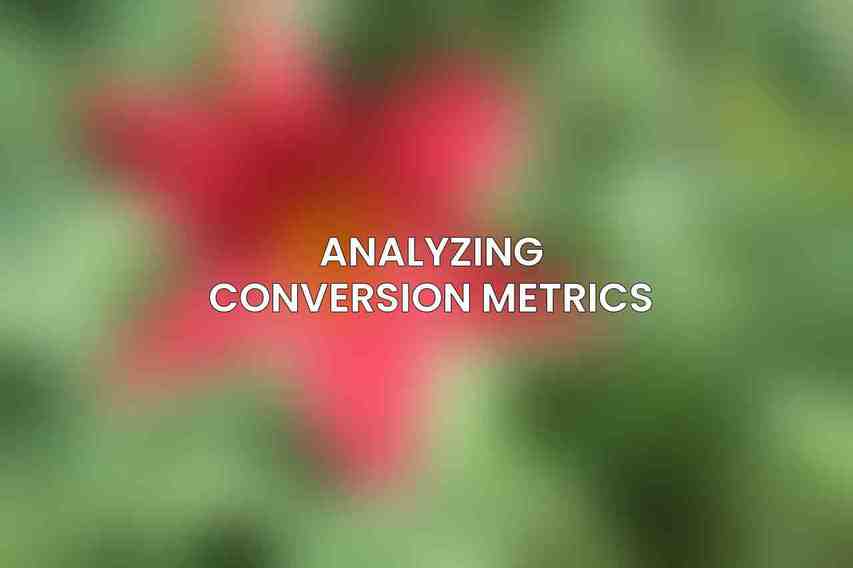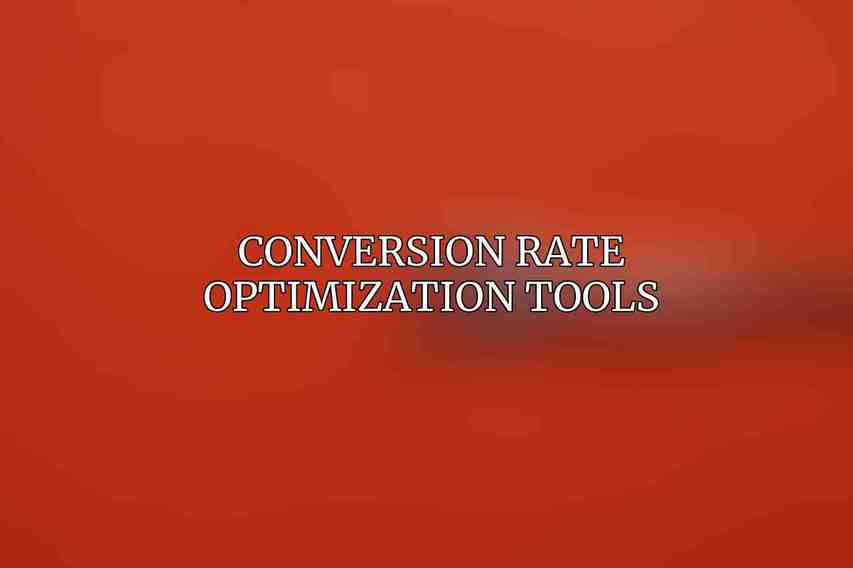Conversion Rate Optimization (CRO) is the practice of enhancing the user experience on a website to increase the percentage of visitors who convert into customers or take a desired action on the site. Key metrics involved in CRO include conversion rate, bounce rate, click-through rate, and average session duration. These metrics help analyze how effectively a website is converting visitors into leads or customers.
One of the primary reasons CRO is essential in digital marketing is its direct impact on the bottom line of a business. By improving conversion rates, businesses can generate more revenue without increasing their advertising spending. Additionally, CRO helps in understanding customer behavior, preferences, and pain points, leading to better-targeted marketing strategies and improved user experience. You can find more information on Top Tools for Performance Analytics and Reporting
Analyzing Conversion Metrics

Conversion Rate Metrics
Understanding different types of conversion rates is crucial for optimizing website performance. These include:1. Overall Conversion Rate: The percentage of visitors who complete a specific goal out of the total number of visitors.2. Micro Conversion Rates: Smaller actions that lead to a macro conversion, such as signing up for a newsletter.3. Macro Conversion Rates: The primary conversion goal, like making a purchase or requesting a demo.
Heatmaps
Heatmaps provide visual representations of user interactions on a website, showing where users click, move, and scroll. By interpreting heatmaps, businesses can identify areas of interest, user engagement, and friction points on their websites, enabling targeted improvements for enhanced user experience.
Bounce Rates
Bounce rate indicates the percentage of visitors who leave a website after viewing only one page. High bounce rates may signify irrelevant content, slow page load times, or poor user experience, prompting the need for optimization strategies to retain visitors and encourage further engagement. Learn more about How to Effectively Track User Engagement
Conversion Optimization Techniques
Implementing various optimization techniques is crucial for improving conversion rates and maximizing the effectiveness of digital marketing efforts. Some key strategies include: Explore further with Essential KPIs for Digital Performance Success
A/B Testing
A/B testing involves creating two or more versions of a web page or element and comparing their performance to determine the most effective option. It helps identify elements that positively impact conversion rates and informs data-driven decisions for website optimization.
Types of A/B Tests
- Copy variations
- Call-to-action buttons
- Design layouts
Best Practices
- Test one element at a time
- Ensure statistically significant results
- Continuously optimize based on data insights
Case Studies
- Example A/B test increasing conversion rates by 20%
Landing Page Optimization
Landing pages play a critical role in converting visitors into leads or customers. Optimizing landing pages involves refining page structure, design elements, copywriting, and form placement to create compelling and user-friendly experiences that drive conversions.
Page Structure and Design
- Clear and concise messaging
- Visually appealing layout
- Mobile responsiveness
Copywriting
- Compelling headlines
- Persuasive call-to-action
- Benefit-oriented content
Form Optimization
- Minimal form fields
- Clear instructions
- Progressive profiling
Value Proposition Optimization
Communicating a strong value proposition is essential for engaging visitors and persuading them to take action. By highlighting unique selling points, leveraging social proof and testimonials, businesses can effectively communicate their value to potential customers and differentiate themselves from competitors.
Communicating Unique Selling Points
- Clear value proposition statement
- Highlight key benefits
- Address customer pain points
Using Social Proof and Testimonials
- Customer reviews
- Case studies
- Influencer endorsements
Case Studies
- Successful value proposition optimization leading to a 30% increase in conversions
Call-to-Action Optimization
Optimizing call-to-action (CTA) elements is crucial for guiding visitors towards desired actions on a website. Factors such as CTA placement, language, style, and design significantly impact conversion rates and user engagement.
Placement and Prominence
- Above the fold
- Contrasting colors
- Strategic positioning
Language and Style
- Action-oriented verbs
- Urgency-driven text
- Personalization
Color and Design
- High-contrast colors
- A/B testing different color schemes
- Consistent branding
Shopping Cart Optimization
Streamlining the shopping cart and checkout process is essential for reducing cart abandonment rates and increasing sales. By simplifying the checkout process, offering secure payment options, implementing upselling and cross-selling strategies, businesses can optimize their online shopping experience for higher conversions.
Simplifying Checkout Process
- Guest checkout option
- Progress indicators
- Clear pricing and shipping information
Reducing Abandoned Carts
- Retargeting strategies
- Cart abandonment emails
- Exit-intent pop-ups
Upselling and Cross-Selling
- Related product recommendations
- Bundle offers
- Limited-time promotions
Content Marketing
Creating and distributing relevant, valuable content is a powerful technique for driving traffic, engaging visitors, and nurturing leads towards conversion. By developing a content strategy that resonates with the target audience and educates, entertains, or inspires them, businesses can build credibility and trust, leading to increased conversions.
Creating Relevant and Engaging Content
- Blog posts
- Videos
- Infographics
Content Distribution and Promotion
- Social media marketing
- Email newsletters
- Influencer collaborations
Content Nurturing
- Lead magnets
- Drip campaigns
- Personalized content recommendations
Email Marketing
Segmenting email lists, personalizing email content, and automating email campaigns are critical components of successful email marketing strategies. By delivering targeted and relevant messages to subscribers based on their preferences and behavior, businesses can increase engagement, brand loyalty, and ultimately drive conversions.
Segmenting Email Lists
- Demographics
- Purchase history
- Engagement levels
Personalizing Email Content
- Dynamic content
- Personalized recommendations
- Tailored messaging
Automating Email Campaigns
- Welcome series
- Abandoned cart emails
- Birthday promotions
Advanced Optimization Techniques
Advanced optimization techniques, such as multivariate testing, personalization, and leveraging artificial intelligence and machine learning, offer sophisticated approaches to improving conversion rates and enhancing user experiences for maximum impact.
Multivariate Testing
Multivariate testing allows businesses to test multiple variations of several elements simultaneously to determine the ideal combination that yields the highest conversion rates. While more complex than A/B testing, multivariate testing provides insights into the combined impact of various elements on user behavior and conversions.
Advantages and Disadvantages
- Simultaneous testing of multiple variables
- Requires substantial traffic for statistical significance
- Comprehensive data insights
Use Cases
- Testing combinations of headlines, images, and CTAs
- Optimizing landing page elements for maximum impact
Case Studies
- Multivariate testing resulting in a 25% increase in lead generation
Personalization
Personalization involves tailoring website content, product recommendations, and marketing messages to individual users based on their preferences, behavior, and demographics. By delivering personalized experiences, businesses can enhance user engagement, build customer relationships, and drive conversions.
Types of Personalization
- Product recommendations
- Dynamic content
- Location-based offers
Data Collection and Segmentation
- Customer profiles
- Behavioral data
- Purchase history
Case Studies
- Personalized product recommendations leading to a 15% uplift in sales
Artificial Intelligence and Machine Learning
The integration of artificial intelligence (AI) and machine learning (ML) technologies in conversion optimization enables automated decision-making based on predictive analytics and user behavior analysis. By leveraging AI-driven algorithms, businesses can optimize website performance, personalize user experiences, and anticipate customer needs for improved conversion rates.
Applications in Conversion Optimization
- Predictive analytics
- Real-time personalization
- Automated content optimization
Case Studies
- AI-powered chatbots increasing conversion rates by 30%
Challenges and Future Trends
- Data privacy concerns
- Algorithm transparency
- Continued advancements in AI capabilities
Key Performance Indicators (KPIs) and Reporting
Measuring conversion-related KPIs and analyzing data insights are vital for monitoring website performance, evaluating the effectiveness of optimization strategies, and making informed decisions to drive continuous improvement.
Conversion-Related KPIs
Key performance indicators related to conversion rates include session duration, pages per visit, average order value, and conversion rate by traffic source. Tracking these metrics provides valuable insights into user behavior, engagement levels, and the overall success of conversion optimization efforts.
Session Duration
- Average time spent on the website
- Engagement with content
- Indicates user interest and website stickiness
Pages per Visit
- Number of pages viewed per session
- Navigation behavior
- Reflects user engagement and interaction with the website
Average Order Value
- Average amount spent per transaction
- Indicates purchasing behavior
- Influenced by pricing strategies and product offerings
Reporting and Data Analysis
Utilizing data visualization tools, generating insightful reports, and applying advanced data analysis techniques are essential for effectively interpreting and acting on data to drive conversion optimization strategies.
Data Visualization and Reporting Tools
- Google Analytics dashboards
- Tableau
- Power BI
Case Studies
- Heatmap analysis revealing high-engagement areas
- A/B test results leading to 15% conversion rate improvement
Data Analysis Techniques
- Cohort analysis
- Funnel analysis
- Segmentation analysis
Conversion Rate Optimization Tools

Various tools and platforms are available to assist businesses in optimizing conversion rates, tracking performance metrics, and implementing data-driven decisions for continuous improvement.
- Google Analytics: A powerful web analytics tool for tracking website traffic, user behavior, and conversion goals.
- Google Optimize: A testing and personalization platform that integrates with Google Analytics for optimizing user experiences.
- Hotjar: A tool for heatmapping, session recording, and user feedback to understand website usability and visitor behavior.
- Crazy Egg: Provides heatmapping, scroll mapping, and A/B testing features to optimize web page performance.
- Optimizely: An experimentation platform for A/B testing, multivariate testing, and personalization to enhance conversion rates and user experiences.
By mastering these conversion rate optimization strategies and techniques, businesses can enhance user experiences, drive higher conversions, and achieve sustainable growth in the competitive digital world. Continuous testing, data analysis, and optimization efforts are key to unlocking the full potential of conversion rate optimization and maximizing the return on investment in digital marketing initiatives. Check this blog on Comprehensive Guide to Understanding Performance Metrics
Frequently Asked Questions
What is Conversion Rate Optimization (CRO)?
Conversion Rate Optimization (CRO) is the process of improving the percentage of website visitors who take a desired action, such as making a purchase or signing up for a newsletter, by optimizing elements on a webpage.
What are some common CRO strategies?
Common CRO strategies include A/B testing, optimizing website design and user experience, creating targeted landing pages, improving website loading speed, and implementing persuasive copywriting and call-to-action buttons.
How can I measure the success of my CRO efforts?
You can measure the success of your CRO efforts by tracking key performance indicators (KPIs) such as conversion rate, bounce rate, average session duration, and revenue generated. Tools like Google Analytics can help you analyze and track these metrics.
What are some best practices for creating effective CTAs?
Some best practices for creating effective call-to-action (CTA) buttons include using action-oriented language, making them visually stand out on the webpage, placing them above the fold, ensuring they are mobile-responsive, and testing different variations to see what works best.
How can I continuously improve my CRO strategy?
To continuously improve your CRO strategy, it’s important to regularly analyze data, conduct A/B tests, gather feedback from users, stay updated on industry trends, and implement changes based on insights and findings. It’s an ongoing process of refinement and optimization.

